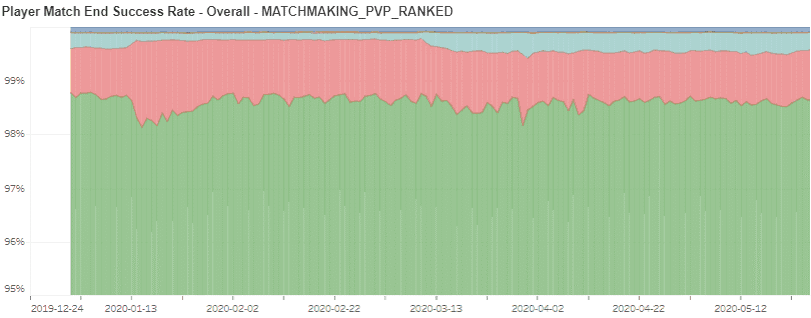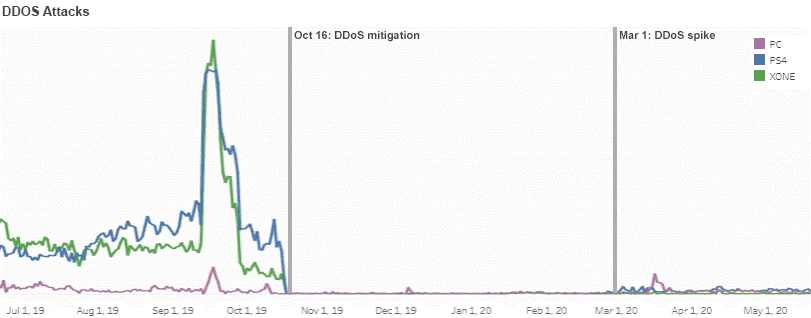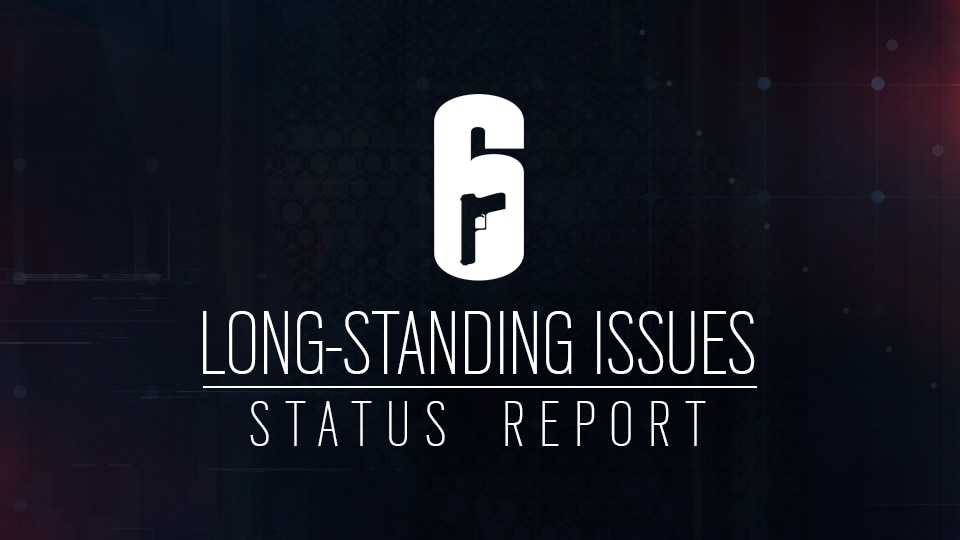| Table of Contents: |
|---|
| 1. Sound Issues |
| 2. Connectivity |
| --- 2.1. Overall Connectivity |
| --- 2.2. Latency Policy |
| 3. Cheating and Disruptive Behavior |
| --- 3.1. DDoS |
| --- 3.2. Boosting |
| --- 3.3. Smurfing |
| --- 3.4. Incomplete Teams |
| --- 3.5. Vote to Kick Abuse |
| --- 3.6. MMR Rollback Frustrations |
| --- 3.7. Streamer Mode |
| 4. Accessibility |
| 5. Smoke Propagation Issues |
| 6. Drone Issues |
With a game that has been around for as long as Siege, we are aware that there are long-standing issues that we have yet to fully resolve. We are dedicated to maintaining and growing the game continually, as we have done for many years before. We appreciate the community’s support throughout the years, and we also thank you for your patience as the game continues to develop.
In this Status Report we will be shedding some light on long-standing topics of player concerns that are very important to us, but also complex to discuss. Our regular Top Issues and Community Concerns blog posts lays out current issues with more finite and short-term fixes. The goal of this Status Report is to share behind-the-scenes insight as to why some of the long-standing issues are so persistent, and how we are approaching solutions to them in the long-run.
While not all of these topics will be addressed in the near future, we do have several things already in the works that we want to share.
1. Sound Issues
Concerns: We are aware that various sound issues in the game have been problematic for players for some time. Sound in Siege is a very complex system which attempts to realistically simulate sound propagation in a 3D environment. In some cases, the complexity of the sound system can be confusing which leads to player misunderstandings—for example, when sound uses a specific route to reach the player, but the player is not aware of that route (like in the case of a Maverick hole). In other cases, this complexity can also mean it can be very difficult to diagnose sound bugs, such as the frequently mentioned inversed audio, or missing sounds.
Challenges: Our sound system takes into account many parameters when serving sounds to players. This includes the player’s position, environment, game state, and more. New components that interact with our sound system get added every Season, and with new elements there are always new opportunities for bugs to be introduced.
Another important factor to consider is that Siege’s destruction engine fosters a constantly changing, dynamic environment. Every round is unique since sound propagation dynamically changes based on the different states of destruction. This adds an extra layer of complexity to reproducing and fixing sound-related issues.
The goal of sound propagation in Siege is to dynamically convey realistic sound direction and position to the players. This is done by dividing our maps into multiple spaces, which allow sound to propagate from one space to another through specific connection points (such as destructible walls, floors, doors and windows). Then depending on the current state of map destruction, the propagation system connects the sound to the listener by calculating the best path. It will check whether the connector points are covered by their corresponding wall, or if a hole was made which would let the sound pass. Once the algorithm determines the optimum pathway, we use this information to position and modulate the sound so players can recognize the sound’s origin and distance.
Future: To get sound in Siege to a better place we have taken multiple actions internally to help us diagnose and fix sound issues. First, we have instrumented the sound system to help us catch errors more quickly. This aims to enable us to identify errors earlier in our development process, as well as debug difficult-to-reproduce problems.
Secondly, we have reviewed the status of our sound and propagation systems. We've reached the conclusion that we need to rebuild large parts of it, starting with the way sounds are packaged and connected to the game. We are aiming to begin releasing the sound repackaging in Season 3. However, the full rebuild of the entire sound propagation and sound interactions systems is a major undertaking that will not be finalized in Year 5.
In the meantime, new bugs that pop up are fixed when proper reproduction can be achieved by our QC teams. This is one of the main roadblocks behind the inverse audio and missing sounds bugs: they seem to occur randomly and cannot be recreated consistently in-house, which makes it very difficult to work on the steps towards a solution. However, we will continue to try reproducing sound bugs as part of our usual processes and fixing them whenever possible. We would also like to ask for the community’s help on this matter. If you find a consistent way of reproducing any sound issues you face, please let us know through R6 Fix, opt in for direct contact in your submission, and we can reach out for more info.
2. Connectivity
Connectivity is a varied topic that encompasses many different areas such as internet service providers, our backend services (such as matchmaking), our game servers, our game server provider, and even DDoS attacks.
2.1 Overall Connectivity
Challenges: Our live and online teams monitor our online services 24/7 to ensure that the game is always available to our players. They are always aware of any degradations that arise and work very hard to resolve them as quickly as possible. Despite their constant surveillance, degradations do still occur. While some degradations can occur due to changes on our end, other times degradations are outside of our control (i.e. third-party degradations). When a degradation occurs, we do our utmost to bring services back online with minimum impact to our players. For prolonged periods of downtime we have a compensation matrix in place.
As an example, at the beginning of the stay-at-home measures in mid-March, the added load on our servers caused degradations in matchmaking and login problems. To answer the increased load and player activity, we scaled up our infrastructure by:
- Doubling the number of servers allocated to processing matchmaking data (distributing the load across more servers to prevent backlogs).
- Adding additional shards (each shard is a separate server instance) to increase the capacity of our databases (increasing database scalability and performance).
- Doubling the capacity of the Rainbow Six Siege load balancer (increasing capacity to be able to distribute network traffic more reliably).
From start to end, the connectivity issues lasted less than a week while we implemented the above measures before returning to normal.
During regular periods of activity, our data indicates that 97% of Ranked games start with 10 players, and more than 98.5% of matches end successfully without individual connection lost, high ping kicks, or game server crashes. The graph below illustrates the overall success rate of Rainbow Six matches since the beginning of the year (in green):

However, a good example of connectivity issues that are not within our control can be seen in the blue section of the graph. The blue section above indicates matches where at least one player was kicked due to high ping. With the start of stay-at-home measures in March, the percentage of high ping kicks has more than doubled due to the additional load placed on the internet globally — a factor we are unable to control.
Future: Our live and online teams are constantly exploring ways to improve the quality of service in Siege. They have been working endlessly behind the scenes since the launch of Siege and continue their efforts to this day.
To improve connectivity performance and resiliency, we migrated our game servers to Linux last year, and this year, work is already underway to improve resiliency in case of third-party outages. To improve horizontal scaling capabilities, improve matchmaking times, and allow for more seamless maintenances, we are working on transitioning our entire backend to a microservices based architecture. As you can imagine, these changes take time. However, we will make our best efforts to make everything seamless and transparent to players, so look forward to more updates from us as these changes go live.
2.2 Latency Policy
Concern: When a player’s ping reaches a certain threshold for a sustained period of time, they are kicked from the game. The current kick threshold is considered too lenient by some in the community.
Challenge: Our current ping thresholds are based on values observed during the 2015 Alpha tests. Connectivity kicks and warning standards for what we deem to be so laggy as to have a negative impact on the game is based on that data. Anything less than a ping of 110ms is considered acceptable and for any values over this, additional checks and verifications are applied to the player’s actions before triggering a kick to remove the player.
Future: We need to maintain an overall quality of play performance for everyone in the game, while allowing some flexibility for potential fluctuations in the normal course of gameplay. Our teams are invested in reducing latency by adding game servers in additional regions—but this will require proper assessments on whether the population in that region would be able to sustain matchmaking while still putting players into matches within a reasonable amount of time. It will also depend on the capacity of our infrastructure providers. (Siege currently maintains servers in West EU, North EU, South Africa, HK, Singapore, Japan, Australia, US West, US East, US Central South and Brazil). As we add more regions and the average player latency is reduced, we may re-evaluate our data and revisit potential changes to ping thresholds.
3. Cheaters and Disruptive Behavior
Cheating in Siege is and will always be a topic of high priority for us. In our latest issue of Top Issues and Community Concerns we outlined the results of some of our short-term tactics to mitigate hackers, cheating, and lobby freezes. We will continue to communicate on anti-cheat measures under the condition that it will not compromise our efforts against cheaters and won’t negatively impact implemented solutions. We do also aim to have a longer-form dev blog on cheating in the near future.
On the subject of toxicity, we take a firm stance against it. We seek to prioritize healthy interactions between players, promote a positive game environment, and uplift a supportive community. Presently, we try to mitigate toxic and disruptive behaviors in game with chat filtering, mute options, Reverse Friendly Fire, keeping all-chat off by default, and the upcoming Match Cancellation feature. The battle against toxicity must ultimately be a collaborative effort between the team and the Siege community, so we will continue to encourage positive behaviors we’d like to see more of.
3.1.DDoS/DoS
Concern: DDoS issues have arisen from time to time as cheaters find different methods to attack vulnerabilities in our systems.
Challenges: We are highly committed to protecting our game from DDoS attacks. We have a dedicated team monitoring network anomalies and DDoS attacks on our servers. However, each case differs and often requires different partners (both internal and external) to investigate and remedy. For instance, a recent rise in reports of DDoS was actually tied to lobby freezing—a different method of disrupting the game. We worked to create a refined detection and tracking method for lobby freezers and then implemented an automatic kick for identified cheaters.
To provide some context, below is a graph that represents the number of successful DDoS attacks on our systems.

In the months leading up to Ember Rise, the number of DDoS attacks rose incredibly quickly. We began implementing a number of measures to put a stop to the attacks, including working closely with external providers. Once our DDoS mitigation solution was activated, we saw the number of successful attacks drop to almost 0.
The situation remained stable until recently, when a rise in DDoS reports in the beginning of March led to our discovery of some new DDoS techniques being used.
Future: We will continue to monitor and investigate DDoS attacks on our servers. Our dedicated DDoS team is currently pursuing several avenues to mitigate new types of attacks we’ve discovered in collaboration with our external cloud provider. We will provide more regular updates on this in our Top Issues and Community Concerns blog posts, or in upcoming patch notes depending on when we have more to share.
3.2. Boosting
Concern: Boosters unfairly inflate the rank of other players via dishonest or illegal means. This is usually done by manipulating our matchmaking systems by smurfing and/or through cheats.
Future: To handle accounts boosted by cheaters, we have a 2-step system that includes banning the cheaters, and then carrying out a MMR rollback. Banned cheaters will trigger MMR rollbacks, and we can identify with quite high confidence players who receive a significant MMR as having been boosted. These boosted players then receive an MMR reset and are required to redo their Season’s placement matches. Furthermore, to reduce boosting, we also implemented a limit on the maximum MMR gap allowed between party members.
Another step to combat boosting is the upcoming unified MMR change. This allows our matchmaking system to properly identify players based on their worldwide MMR rather than their regional one should they change servers (therefore allowing them to play at their Seasonal MMR reset’s value for a short period).
Unfair matchmaking caused by players who are misrepresenting their actual skill level is an issue we will continuously strive to improve on.
3.3. Smurfing
Concern: Smurfs create imbalances in matchmaking when they use new accounts to hide their actual skill level. Our matchmaking system does not use Clearance Level, K/D, or win rate to carry out matchmaking. It uses MMR. MMR is determined by your match’s outcome, while taking into account the enemy team’s MMR. By disguising their true skill level, smurfs impact the competitive balance of the match with very few ways for us to verify the incident.
Challenges: Smurfing is a struggle the entire industry faces and in our community, it damages the playing experience.
Our User Research team will continue to work to improve our understanding and analysis of this topic in the future, however a major difficulty lies in the limited tracking. Smurfs are difficult to identify, and we need a way to do so before making any changes to our system to combat these players. Currently, our team is using the available data to detect outliers that would indicate smurfing. In the meanwhile, we will continue to enforce measures such as 2-Step Verification to add barriers to multiple accounts creation.
3.4. Incomplete Teams
Challenge: Games that begin with an unequal number of players are extremely frustrating, and this kind of disadvantage goes against our goal of fair, balanced, and enjoyable games. While the Ranked playlist does allow players to rejoin the games they were in, we do realize that rejoining does not always occur.
Future: In Year 5 Season 2, we have announced the introduction of a new Match Cancellation feature. This will not ship at Season launch but later on during the Season.
To create the new Match Cancellation feature, we had to ensure that the system would not be exploitable and easily abused by players who wanted to bail on a game after loading in. Many situations and parameters had to be evaluated to set up criteria under which disadvantaged teams would be able to justify cancelling a match—such as momentary disconnects needing a chance to rejoin and how the voting system would work. Match Cancellation will give the disadvantage team the agency of cancelling the match when all our criteria for a potential cancellation is met. We are excited to share this with you in our next Season.
3.5. Vote To Kick Abuse
Concern: While Vote to Kick is no longer an option in Ranked Games, we often see Quick Match players reporting frustrations over the abuse of this function. The intention of this feature is to provide players with an option to remove a teammate should they exhibit problematic behavior; however, the original intent has sometimes been manipulated by some to create toxicity.
Challenges: We are aware of how this function has been abused and we agree that a redesign of the Vote to Kick rules is in order. There are multiple ways this feature has been abused and we are currently assessing the data to understand the various scenarios and how we can block openings for abuse. We have identified a few starting points, such as preventing players under certain sanctions from voting, and we are currently going over the Vote to Kick designs with the goal of having an upgrade live by Season 4.
3.6. MMR Rollback Frustrations
Concern: We often hear feedback from players regarding MMR rollback frustrations when players who manage to win against cheaters still have their games rolled back.
Challenges: When we first introduced MMR rollbacks, there were concerns of massive MMR drops to the unwilling/unknowing teammates of the cheater if games where cheaters lose are not cancelled. As an unwilling teammate, all the matches you’d won together are rolled back (thus losing MMR), but all the games lost together will not get cancelled either (and therefore, the lost MMR still remains).
This is a non-issue if teammates are players who knowingly were in a squad with a cheater. However, in many cases where accounts are hacked by cheaters or teammates are just unknowingly playing with a cheater, this can be exceptionally hurtful to a legitimate but unsuspecting player.
Future: With the recently introduced MMR Reset, this partially mitigates some of the potential massive MMR Rollback concerns outlined above. When there is a large enough MMR rollback, players affected will have their MMR reset and be required to re-do their placement matches. We will be exploring what other risks there might be in only rolling back games where cheaters win in the near future.
3.7. Streamer Mode
Concern: We want to provide streamers with a layer of anonymity to maintain their gaming experience against major frustrations such as stream sniping.
Challenges: We are exploring a few options and need to find a solution where we would still be able to internally identify players while Streamer Mode is on—while providing public-facing anonymity.
Future: We have an early iteration of a potential solution which we discussed with a select few streamers. While the initial reception was positive, we need to make sure the feature is as bulletproof as possible security-wise to ensure there are no workarounds to affect anonymity while still allowing us to trace our players and player data when a different identity is used. We are continuing to iterate on the design and validating to see if we can break down this feature into more intermediate deliverables.
We are committed to providing tools where content creators can communicate with their community and express their passion safely. At the same time, we will continue to take feedback to ensure that our system is robust and aligned with our players’ expectations.
4. Accessibility
Challenges: Player accessibility is important to us and the continued growth of Siege. Our vision for greater accessibility involves a full-fledged colorblind solution as a system that allows players the option to re-color claymores, laser sights, camera lights, etc.—while also taking into account which team you’re on for proper feedback.
Our earlier initiatives for implementing colorblind solutions did not live up to our expectations when tested with colorblind players. We learned that filters alone were not sufficient answers to most of the issues, and in some cases, it even created additional problems. We needed to implement a proper solution offering full-spectrum color selection. Customization at this level entails separating multiple elements for dynamic re-coloring—a significant task we have decided to split into smaller parts.
We are revisiting colorblindness in the near future. We will begin by focusing on improving the shooting experience first through taking a look at reticle colors and what can be done there. We hope to have something to share soon.
This is the first step in putting in place a flexible and comprehensive system. Many of our accessibility team’s resources are currently focused on adding what’s outlined in the Communications and Video Accessibility Act to the game. This will come with other accessibility improvements not specifically targeting colorblindness.
5. Smoke Propagation Issues
Concern: Smoke propagation as it currently stands is unreliable and confusing. The core of the problem is that small interior environments do not work well with our current smoke propagation system to allow for realistic gas positioning. As a result, we often see smoke clipping issues which, in the case of Smoke’s gadget also causes damage.
Challenge: We have previously explored solutions for smoke propagation by expanding on Capitão’s reworked fire propagation system. However, that system was not built to handle large layers of very dense gas like that of smoke grenades or Smoke’s gadget. Using Capitão’s fire propagation system on these kinds of smokes would cause massive drops in performance, negatively affecting gameplay and player experience.
Future: We have tried a few smaller fixes and workarounds on the system, but the results were unsatisfactory. We have concluded that we will need to overhaul the smoke propagation system, which will involve sizable work on the graphics and engine side to ensure good visual quality while maintaining a solid framerate. This is currently on hold until we have the time and resources to address it. We will communicate further when we have more to share.
6. Drone Issues
Concern: Various drone-related bugs will pop up from time to time. These are varied, but frustrating as droning and gathering intel is a big part of the game.
Challenge: As the game grows, the drone system has become overly complex with many different moving parts. Sometimes, when making new changes to drones, we may unintentionally affect other parts of the system.
Future: We will continue to investigate drone bugs as they arise and will work to fix them as soon as possible.
We are also migrating the drone system to our new gadget v2 system, which is designed to simplify, streamline, and decouple systems. Migration of some gadgets to this system been done transparently in the past year, and we will continue to improve all our gadgets in this way to help them be more resilient to exploits, and iterate faster. Automatic tests have also been added to identify regressions as soon as they occur. In some cases, bugs are caused by complex interactions with the drone system—or the game at large. Those complex cases should be addressed once our migration to the gadget v2 framework is complete.
Next up
If you’ve made it to this paragraph, you’ve made your way through a very long list of long-term goals and promises. But we have good news for the near future too. We have got some community requests that -are- coming soon such as the alpha of the match replay system, map pick-and-ban, and various reworks. Plus, we’ve got even more things on the horizon that we are excited to share such as the reputation system, ping 2.0, and more. We look forward to continuing to build on the game with all of you!
For regular updates on Rainbow Six Siege, continue to look out for our patch notes, dev blogs, designer’s notes, Top Issues and Community Concerns articles, and Seasonal reveal panels. We aim to improve communications on a few key topics such as cheating, connectivity, and matchmaking—we will be releasing dev blogs touching on those in the near future.











